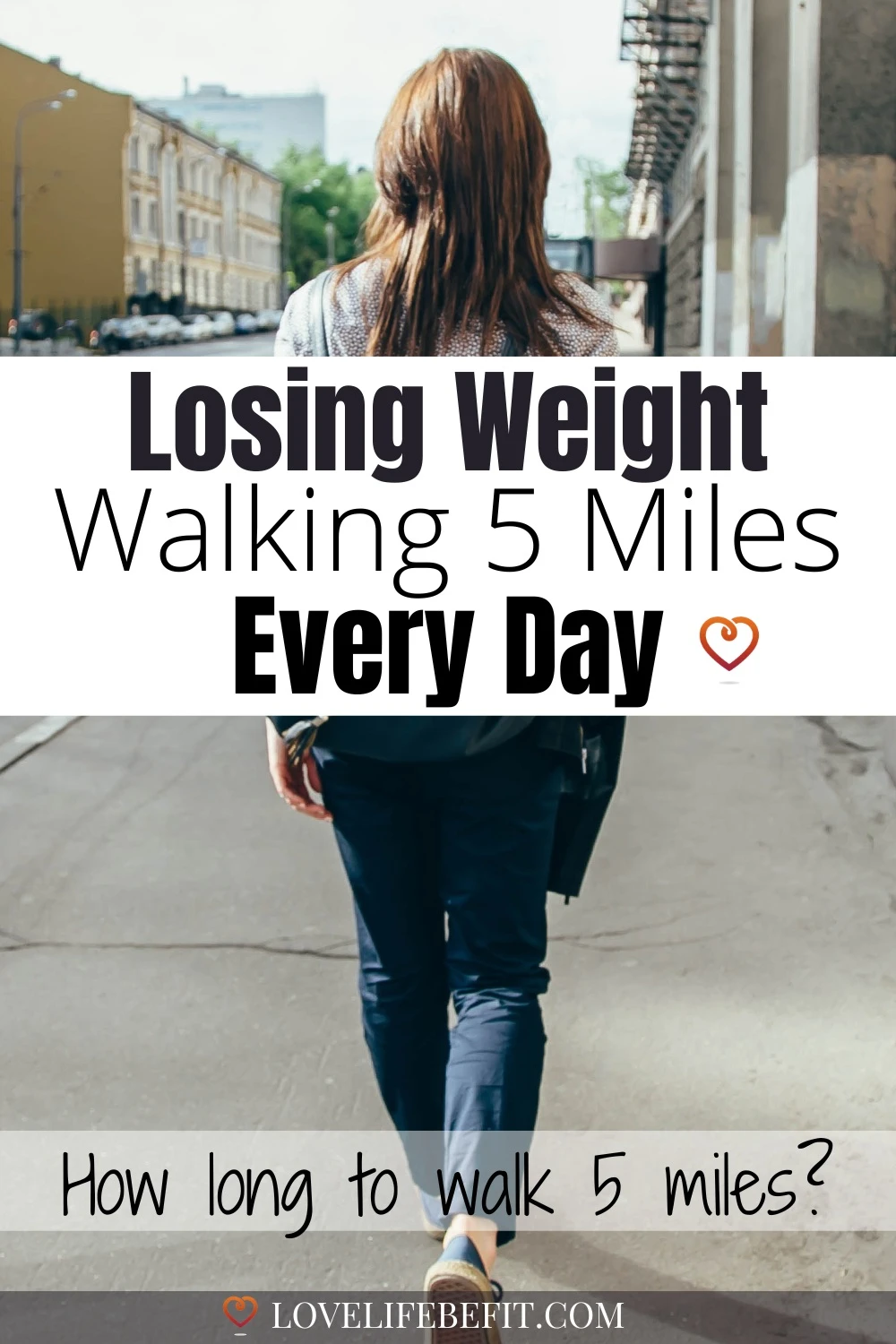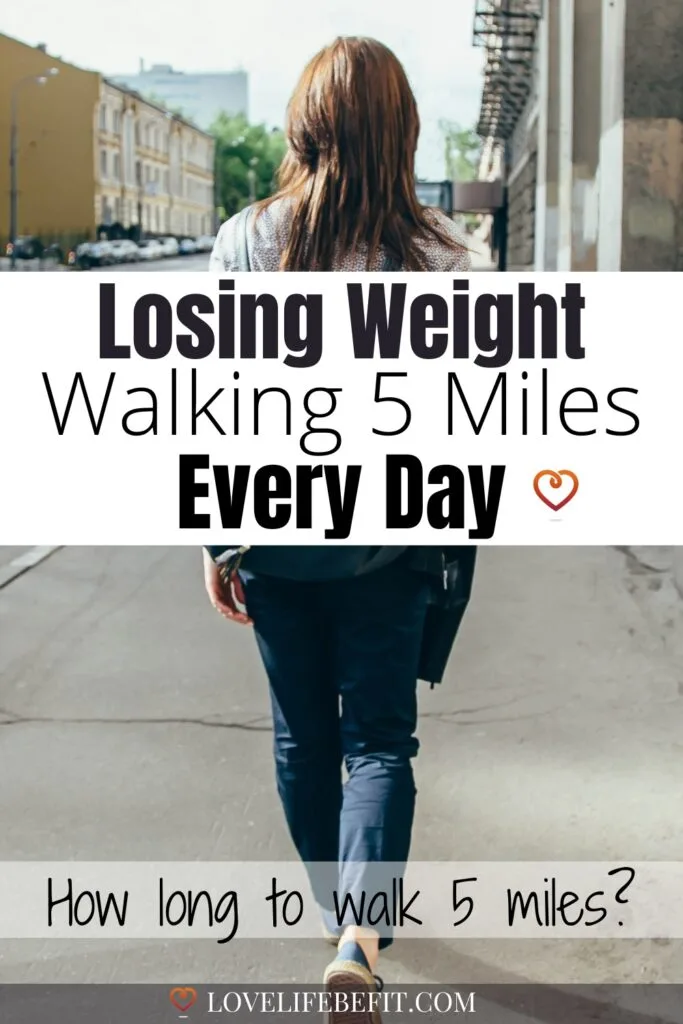Thinking about starting a walking program and walking 5 miles a day? Then you’ll want to know how long does it take to walk 5 miles.
Walking times depend on your walking pace and average walking speed. If you walk at a pace of 4 mph you’ll be faster than at a more moderate pace of 3 mph.
But what is a typical walking speed? The average pace varies depending on your age and sex but fitness level makes the biggest difference. Most people are capable of walking faster.
Walking has huge benefits for your physical and mental health. It’s a great way to meet the guidelines for physical activity. This guide explores different times to walk 5 miles from an easy walk pace on the flat to walking uphill or at a fast pace or jog.

How Far Is 5 Miles
5 miles is 8,800 yards or 8,047 meters – a little over 8 kilometers.
How many steps in 5 miles?
Prefer to count distance in steps? The number of steps it takes to walk 5 miles will depend on fitness levels, average step length (stride length), and pace.
As a rough guide, walking 5 miles is equivalent to 10,000 to 12,000 steps. You’ll complete a 10,000 steps a day challenge if you walk 5 miles each day.

How Long Does It Take To Walk 5 Miles?
The time it takes to walk 5 miles depends on your walking speed. Most people walk at a pace between 3 to 4 mph and the average person roughly takes 75 to 100 minutes to walk 5 miles.
Walking speed will depend on your fitness, terrain, elevation, and effort level. Even the weather can have an effect. The average walking pace varies based on a person’s age and sex.
For slow walkers, 5 miles can take up to 2 hours 30 minutes walking at a pace of 2 mph. This is slower than a typical easy pace of 2.5 mph.
If you can power walk – times of up to 5 mph are possible. That’s fast! It’s equivalent to the average jogging pace. At this speed, it takes just 60 minutes to walk 5 miles.
If you know your walking pace, you can find out how long it takes to walk 5 miles from the following chart:
| Walking Speed (mph) | Walking Pace (min/mile) | Time Taken To Walk 5 Miles (hour: min) |
| 2.0 | 30.0 | 2:30 |
| 2.5 | 24.0 | 2:00 |
| 2.75 | 21.8 | 1:49 |
| 3.0 | 20.0 | 1:40 |
| 3.25 | 18.5 | 1:33 |
| 3.5 | 17.1 | 1:26 |
| 3.75 | 16.0 | 1:20 |
| 4.0 | 15.0 | 1:15 |
| 4.25 | 14.1 | 1:11 |
| 4.5 | 13.3 | 1:07 |
| 4.75 | 12.6 | 1:03 |
| 5.0 | 12.0 | 1:00 |
Find out how long it takes to walk 6 miles.

What Is The Average Walking Speed By Age And Sex?
Walking speed decreases with age. It’s the main factor determining how fast you walk. Older people generally walk at a slow pace.
But sex, height, fitness level, muscle mass, stride length, and body weight are also important factors.
Of course, not everyone fits into these trends. These are average speeds. An older person who’s stayed fit and healthy all their life will walk much faster than the average speed.
Research into average walking speeds is very limited. Most sources quote the Schimpl, Moore et al research or the 5-decade study in New Zealand.
Walking pace to walk 5 miles
The 5-decade study in New Zealand, for people born in 1972-73, measured walking pace for the 997 participants still alive at 45. The study found average walking speed was 1.30 m/s for usual walking gait and 1.99 m/s for maximum gait.
Converting to miles per hour provides an average speed of 2.91 mph for usual walking gait and 4.45 mph for maximum gait.
That’s a range of 68 to 103 minutes to walk 5 miles.
This study tested walkers over short distances. The results will be artificially high compared with completing a 5-mile walk.
Most people slow down over longer distances
It makes sense that it’s harder to maintain speed the further you walk. It’s a good idea to test out different walking speeds. Use a fitness tracker to measure your pace or time yourself over a set distance using a stopwatch.
Walk at an easy pace, a moderate pace, and a brisk pace. A brisk pace is where your heart rate is elevated and you’re making an effort but you can still walk and talk. Which of these paces could you keep up over a long distance?
When you’re walking 5 miles for the first time it’s best to set off at a moderate pace. You can always increase your speed over the last mile.
Depending on your fitness level, your time over 5 miles will be slower than the time it takes to walk one mile.
How Long Does It Take To Walk 5 Miles By Age?
The Schimpl, Moore et al study tested donors at the Cambridge Blood Center and looked into the effect of age, sex, and BMI on walking speeds.
The study found that sex and BMI were surprisingly insignificant but walking speed declined with age.
The table below uses the median values from this study by Schimpl, Moore et al. to calculate the average walking speed for different ages and corresponding times to walk 5 miles:
| Age Range | Average Walking Speed (miles per hour) | How Long Does It Take To Walk 5 Miles? (minutes: seconds) |
| < 30 | 3.0 | 100:00 |
| 30 – 39 | 2.81 | 106:46 |
| 40 – 49 | 2.81 | 106:46 |
| 50 – 59 | 2.75 | 109:05 |
| > 60 | 2.70 | 111:07 |
This table doesn’t include results for walkers over 70. At this age, walking pace depends on an individual’s health, and average values are less meaningful.

How Long Does It Take To Walk 5 Miles By Sex
The same study by Schimpl, Moore et al provided some differences in walking paces for men and women. The results are not very believable – they provide suspiciously identical figures for walking speeds for all men aged 30 to 59. However, we have reproduced the figures below and calculated the average times to walk 5 miles for men and women.
| Age | Average Walking Speed for Women (miles per hour) | Average Time to Walk 5 Miles Women (minutes: seconds) |
| 20-29 | 3.0 | 100:00 |
| 30-39 | 3.0 | 100:00 |
| 40-49 | 3.11 | 96:28 |
| 50-59 | 2.93 | 102:23 |
| 60-69 | 2.77 | 108:18 |
| Age | Average Walking Speed for Men (miles per hour) | Average Time to Walk 5 Miles Men (minutes: seconds) |
| 20-29 | 3.4 | 88:14 |
| 30-39 | 3.2 | 93:45 |
| 40-49 | 3.2 | 93:45 |
| 50-59 | 3.2 | 93:45 |
| 60-69 | 3.0 | 100:00 |
It makes sense that on average men would walk faster than women – they are typically taller will longer stride lengths and have greater muscle mass.
These tables don’t take into account a decline in speed over distance – so don’t be alarmed if your average pace is a little slower.
Related post: Average Walking Speed By Age And Sex (How Fast Can You Walk)
Walking Uphill
The time taken slows down drastically when you add hills. Naismith’s rule, named after the Scottish mountaineer William Naismith who conceived his rule in 1892, continues to be an accurate guide for the time taken to walk uphill.
Based on Naismith’s rule, a 5-mile walk with 2000 feet of elevation gain will take 2 hours 40 minutes. Add an extra hour for every extra 2000 feet of climbing.
Find out more about hiking 5 miles and how many calories do you burn walking uphill?

Tips To Walk Faster
Walking is good for weight loss and as the pounds drop off you’ll find you naturally increase your walking speed.
However, just like running, you can train to walk at a faster pace. Here are some tips to become a speedy walker:
#1 Walk Regularly
Take a brisk walk at least 3 times a week – 5 times a week is best for maximum improvement.
#2 Upgrade Your Walking Shoes
If your walking shoes or trainers are old and lacking in support and cushioning, it’s time for an upgrade. Aim to change your shoes every 500 miles – more frequently if you also wear them for casual use.
#3 Walk Properly
Walking may be natural but so many of us pick up bad habits. Take a look at this beginner walking plan with tips to walk properly.
#4 Interval Walking
Add an interval walking workout to your training plan once a week. Log your progress and you’ll start to see improvements.
#5 Use Your Arms
Your arms are so important for walking – use them! Move your arms back and forth bent at 90 degrees. Don’t swing them across your body.
Keep your hands relaxed. It’s best not to carry anything in your hands – carrying a water bottle in your hands or hand weights makes you clench your upper body and slows down your walking pace.
#6 Increase Step Rate
Practice increasing the frequency of your steps. Make sure you roll through your feet and push off with your toes. Your arms should be synchronized with your leg movement.

Thoughts From Love Life Be Fit
Walking 5 miles every day is great for calorie burn and will help you lose weight. Regular walking provides numerous health benefits from improved cardiovascular health to reducing the risk of type 2 diabetes. Most people benefit from spending time in the fresh air: it’s good for your mental health and can help you sleep well at night.
If you’re new to walking, build up to walking 5 miles a day gradually with our Fat Buster Walking Plan. You could even try walking 6 miles a day!
Think 5 miles is too far? Find out how long does it take to walk 4 miles or how long does it take to walk 2 miles.

